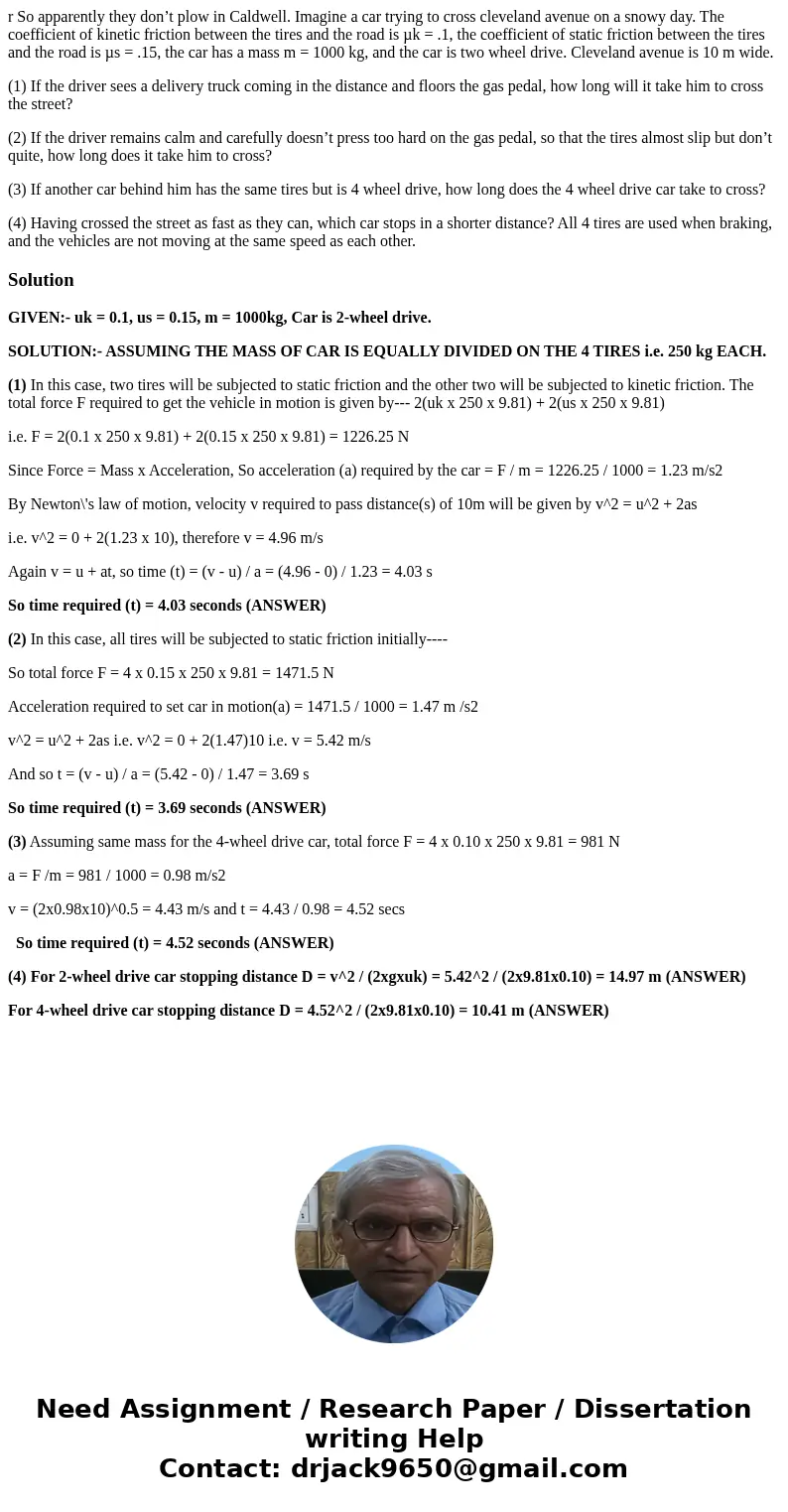r So apparently they dont plow in Caldwell Imagine a car try
r So apparently they don’t plow in Caldwell. Imagine a car trying to cross cleveland avenue on a snowy day. The coefficient of kinetic friction between the tires and the road is µk = .1, the coefficient of static friction between the tires and the road is µs = .15, the car has a mass m = 1000 kg, and the car is two wheel drive. Cleveland avenue is 10 m wide.
(1) If the driver sees a delivery truck coming in the distance and floors the gas pedal, how long will it take him to cross the street?
(2) If the driver remains calm and carefully doesn’t press too hard on the gas pedal, so that the tires almost slip but don’t quite, how long does it take him to cross?
(3) If another car behind him has the same tires but is 4 wheel drive, how long does the 4 wheel drive car take to cross?
(4) Having crossed the street as fast as they can, which car stops in a shorter distance? All 4 tires are used when braking, and the vehicles are not moving at the same speed as each other.
Solution
GIVEN:- uk = 0.1, us = 0.15, m = 1000kg, Car is 2-wheel drive.
SOLUTION:- ASSUMING THE MASS OF CAR IS EQUALLY DIVIDED ON THE 4 TIRES i.e. 250 kg EACH.
(1) In this case, two tires will be subjected to static friction and the other two will be subjected to kinetic friction. The total force F required to get the vehicle in motion is given by--- 2(uk x 250 x 9.81) + 2(us x 250 x 9.81)
i.e. F = 2(0.1 x 250 x 9.81) + 2(0.15 x 250 x 9.81) = 1226.25 N
Since Force = Mass x Acceleration, So acceleration (a) required by the car = F / m = 1226.25 / 1000 = 1.23 m/s2
By Newton\'s law of motion, velocity v required to pass distance(s) of 10m will be given by v^2 = u^2 + 2as
i.e. v^2 = 0 + 2(1.23 x 10), therefore v = 4.96 m/s
Again v = u + at, so time (t) = (v - u) / a = (4.96 - 0) / 1.23 = 4.03 s
So time required (t) = 4.03 seconds (ANSWER)
(2) In this case, all tires will be subjected to static friction initially----
So total force F = 4 x 0.15 x 250 x 9.81 = 1471.5 N
Acceleration required to set car in motion(a) = 1471.5 / 1000 = 1.47 m /s2
v^2 = u^2 + 2as i.e. v^2 = 0 + 2(1.47)10 i.e. v = 5.42 m/s
And so t = (v - u) / a = (5.42 - 0) / 1.47 = 3.69 s
So time required (t) = 3.69 seconds (ANSWER)
(3) Assuming same mass for the 4-wheel drive car, total force F = 4 x 0.10 x 250 x 9.81 = 981 N
a = F /m = 981 / 1000 = 0.98 m/s2
v = (2x0.98x10)^0.5 = 4.43 m/s and t = 4.43 / 0.98 = 4.52 secs
So time required (t) = 4.52 seconds (ANSWER)
(4) For 2-wheel drive car stopping distance D = v^2 / (2xgxuk) = 5.42^2 / (2x9.81x0.10) = 14.97 m (ANSWER)
For 4-wheel drive car stopping distance D = 4.52^2 / (2x9.81x0.10) = 10.41 m (ANSWER)

 Homework Sourse
Homework Sourse